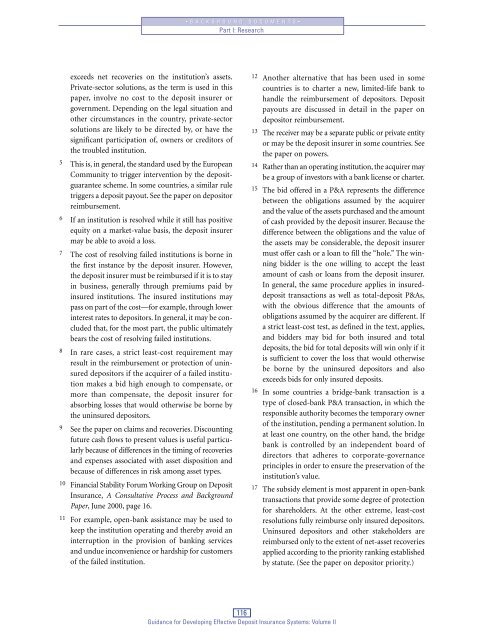Volume II - PDF - International Association of Deposit Insurers
Volume II - PDF - International Association of Deposit Insurers
Volume II - PDF - International Association of Deposit Insurers
- No tags were found...
Create successful ePaper yourself
Turn your PDF publications into a flip-book with our unique Google optimized e-Paper software.
•BACKGROUND DOCUMENTS•<br />
Part I: Research<br />
exceeds net recoveries on the institution’s assets.<br />
Private-sector solutions, as the term is used in this<br />
paper, involve no cost to the deposit insurer or<br />
government. Depending on the legal situation and<br />
other circumstances in the country, private-sector<br />
solutions are likely to be directed by, or have the<br />
significant participation <strong>of</strong>, owners or creditors <strong>of</strong><br />
the troubled institution.<br />
5 This is, in general, the standard used by the European<br />
Community to trigger intervention by the depositguarantee<br />
scheme. In some countries, a similar rule<br />
triggers a deposit payout. See the paper on depositor<br />
reimbursement.<br />
6 If an institution is resolved while it still has positive<br />
equity on a market-value basis, the deposit insurer<br />
may be able to avoid a loss.<br />
7 The cost <strong>of</strong> resolving failed institutions is borne in<br />
the first instance by the deposit insurer. However,<br />
the deposit insurer must be reimbursed if it is to stay<br />
in business, generally through premiums paid by<br />
insured institutions. The insured institutions may<br />
pass on part <strong>of</strong> the cost—for example, through lower<br />
interest rates to depositors. In general, it may be concluded<br />
that, for the most part, the public ultimately<br />
bears the cost <strong>of</strong> resolving failed institutions.<br />
8 In rare cases, a strict least-cost requirement may<br />
result in the reimbursement or protection <strong>of</strong> uninsured<br />
depositors if the acquirer <strong>of</strong> a failed institution<br />
makes a bid high enough to compensate, or<br />
more than compensate, the deposit insurer for<br />
absorbing losses that would otherwise be borne by<br />
the uninsured depositors.<br />
9 See the paper on claims and recoveries. Discounting<br />
future cash flows to present values is useful particularly<br />
because <strong>of</strong> differences in the timing <strong>of</strong> recoveries<br />
and expenses associated with asset disposition and<br />
because <strong>of</strong> differences in risk among asset types.<br />
10 Financial Stability Forum Working Group on <strong>Deposit</strong><br />
Insurance, A Consultative Process and Background<br />
Paper, June 2000, page 16.<br />
11 For example, open-bank assistance may be used to<br />
keep the institution operating and thereby avoid an<br />
interruption in the provision <strong>of</strong> banking services<br />
and undue inconvenience or hardship for customers<br />
<strong>of</strong> the failed institution.<br />
12 Another alternative that has been used in some<br />
countries is to charter a new, limited-life bank to<br />
handle the reimbursement <strong>of</strong> depositors. <strong>Deposit</strong><br />
payouts are discussed in detail in the paper on<br />
depositor reimbursement.<br />
13 The receiver may be a separate public or private entity<br />
or may be the deposit insurer in some countries. See<br />
the paper on powers.<br />
14 Rather than an operating institution, the acquirer may<br />
be a group <strong>of</strong> investors with a bank license or charter.<br />
15 The bid <strong>of</strong>fered in a P&A represents the difference<br />
between the obligations assumed by the acquirer<br />
and the value <strong>of</strong> the assets purchased and the amount<br />
<strong>of</strong> cash provided by the deposit insurer. Because the<br />
difference between the obligations and the value <strong>of</strong><br />
the assets may be considerable, the deposit insurer<br />
must <strong>of</strong>fer cash or a loan to fill the “hole.” The winning<br />
bidder is the one willing to accept the least<br />
amount <strong>of</strong> cash or loans from the deposit insurer.<br />
In general, the same procedure applies in insureddeposit<br />
transactions as well as total-deposit P&As,<br />
with the obvious difference that the amounts <strong>of</strong><br />
obligations assumed by the acquirer are different. If<br />
a strict least-cost test, as defined in the text, applies,<br />
and bidders may bid for both insured and total<br />
deposits, the bid for total deposits will win only if it<br />
is sufficient to cover the loss that would otherwise<br />
be borne by the uninsured depositors and also<br />
exceeds bids for only insured deposits.<br />
16 In some countries a bridge-bank transaction is a<br />
type <strong>of</strong> closed-bank P&A transaction, in which the<br />
responsible authority becomes the temporary owner<br />
<strong>of</strong> the institution, pending a permanent solution. In<br />
at least one country, on the other hand, the bridge<br />
bank is controlled by an independent board <strong>of</strong><br />
directors that adheres to corporate-governance<br />
principles in order to ensure the preservation <strong>of</strong> the<br />
institution’s value.<br />
17 The subsidy element is most apparent in open-bank<br />
transactions that provide some degree <strong>of</strong> protection<br />
for shareholders. At the other extreme, least-cost<br />
resolutions fully reimburse only insured depositors.<br />
Uninsured depositors and other stakeholders are<br />
reimbursed only to the extent <strong>of</strong> net-asset recoveries<br />
applied according to the priority ranking established<br />
by statute. (See the paper on depositor priority.)<br />
116<br />
Guidance for Developing Effective <strong>Deposit</strong> Insurance Systems: <strong>Volume</strong> <strong>II</strong>
















